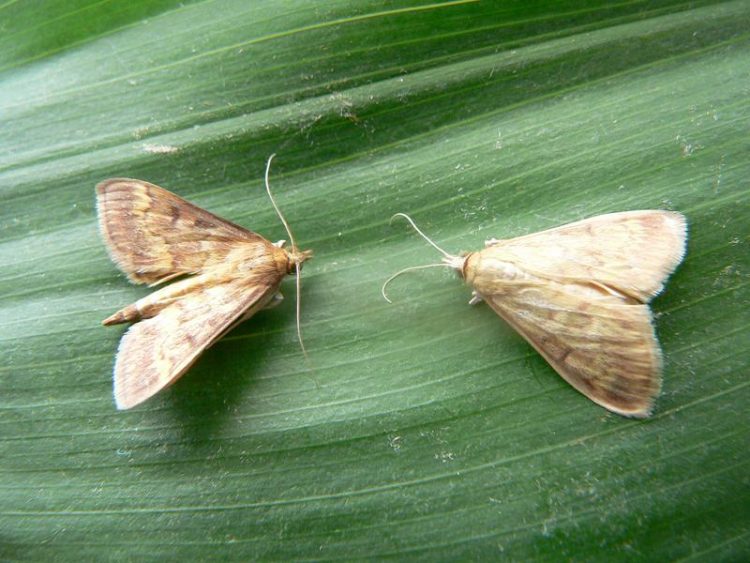Choosing a mate: It's the brain, not the nose, that knows

A male and female moth of the European Corn Borer Ostrinia nubilalis: Understanding the pheromone communication in this insect may contribute to a better pest control. Melanie Unbehend / Max Planck Institute for Chemical Ecology
Female moths produce a sex pheromone, a different blend of chemicals for each species, which attracts males from a distance. Males detect these chemicals with exquisitely sensitive hair-like structures in the antenna. These hairs contain specialized neurons, nerve cells that express pheromone receptors which are activated when they bind to individual pheromone components.
Different species have different pheromone receptors, and so the ability to most accurately smell females of the same species prevents attraction to other females. Solving the puzzle of why a certain pheromone receptor is activated only by a specific chemical has motivated much past research.
“Our previous work in mapping the pheromone receptors of the European Corn Borer convinced us that this species doesn't fit the mold, and so we took another approach,” says lead author Fotini Koutroumpa.
The European Corn Borer uses a simple pheromone with only two isomeric compounds, identical except for the orientation of a double bond. The two “pheromone strains” of this species produce them in different proportions. E-strain females make mostly the E isomer with traces of the Z isomer, which is highly attractive to E-strain males. Z-strain females release the opposite ratio, attracting Z-strain males.
In both cases, both components are absolutely necessary for attraction, and males of both strains can smell both, with similar or identical antennal structures and pheromone receptors. So what difference among the E and Z males could explain their opposite preferences? “We decided to look for a difference at the genetic level”, says co-author Astrid Groot.
By crossing the E and Z strains in the laboratory and mapping the gene governing male preference, the researchers found that the pheromone receptors had little or no effect. Instead, a chromosomal region containing genes involved in neuronal development explained most of the male behavioral response. “This result fits with our previous work showing that E and Z males have different connections between the brain and the neurons containing pheromone receptors,” explains co-author Teun Dekker.
This suggests that females of the E or Z strain smell the same to both E and Z males, while their preferences are controlled not by their noses but instead by their brains. “This result will point future research towards the tiny but complex moth brain, and shed light on how the diverse pheromone systems of the thousands of moth species has changed throughout evolution,” concludes co-author David Heckel. [DGH]
Original Publication:
Koutroumpa, F. A., Groot, A. T., Dekker, T., Heckel, D. G. (2016). Genetic mapping of male pheromone response in the European Corn Borer identifies candidate genes regulating neurogenesis. Proceedings of the National Academy of Sciences of the United States of America (Early Edition), DOI: 10.1073/pnas.1610515113
http://dx.doi.org/10.1073/pnas.1610515113
Further Information:
David G. Heckel, Max Planck Institute for Chemical Ecology, Hans-Knöll-Str. 8, 07743 Jena, Germany, +49 3641 57 1500, heckel@ice.mpg.de
Contact and Media Requests:
Angela Overmeyer M.A., Max Planck Institute for Chemical Ecology, Hans-Knöll-Str. 8, 07743 Jena, +49 3641 57-2110, E-Mail overmeyer@ice.mpg.de
Download high-resolution images via http://www.ice.mpg.de/ext/downloads2016.html
Media Contact
All latest news from the category: Life Sciences and Chemistry
Articles and reports from the Life Sciences and chemistry area deal with applied and basic research into modern biology, chemistry and human medicine.
Valuable information can be found on a range of life sciences fields including bacteriology, biochemistry, bionics, bioinformatics, biophysics, biotechnology, genetics, geobotany, human biology, marine biology, microbiology, molecular biology, cellular biology, zoology, bioinorganic chemistry, microchemistry and environmental chemistry.
Newest articles

Sea slugs inspire highly stretchable biomedical sensor
USC Viterbi School of Engineering researcher Hangbo Zhao presents findings on highly stretchable and customizable microneedles for application in fields including neuroscience, tissue engineering, and wearable bioelectronics. The revolution in…

Twisting and binding matter waves with photons in a cavity
Precisely measuring the energy states of individual atoms has been a historical challenge for physicists due to atomic recoil. When an atom interacts with a photon, the atom “recoils” in…

Nanotubes, nanoparticles, and antibodies detect tiny amounts of fentanyl
New sensor is six orders of magnitude more sensitive than the next best thing. A research team at Pitt led by Alexander Star, a chemistry professor in the Kenneth P. Dietrich…





















